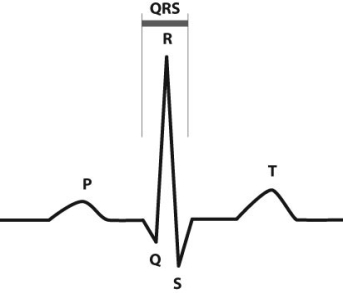Electrocardiographs (ECGs or EKGs) provide data about the electrical activity of the heart. By placing a series of "leads" on a person's chest, the electrical activity of the heart can be recorded and analyzed in order to detect irregular heartbeats (arrhythmias) and other conditions. The figure below shows a normal EKG tracing for one cardiac cycle.
 The P region represents electrical activity spreading through the atria. The QRS region represents electrical activity spreading through the ventricles. The T region represents electrical activity in the ventricles returning to rest.
The P region represents electrical activity spreading through the atria. The QRS region represents electrical activity spreading through the ventricles. The T region represents electrical activity in the ventricles returning to rest.
-Suppose a person has a heart rate of 60 beats/min and that the start of the P region until the end of the T region represents one cardiac cycle. If the x axis in the EKG is time, approximately how much time passes between the start of the P region and the end of the T region?
A) 0.1 second
B) 1 second
C) 10 seconds
D) 60 seconds
Correct Answer:
Verified
Q71: To evaluate cardiac function, scientists and physicians
Q72: To evaluate cardiac function, scientists and physicians
Q73: The anterior interventricular artery supplies a portion
Q74: Which of the following describes the stage
Q75: Ventricular contraction normally begins at the apex
Q77: Ron and Tiffany are studying circulatory
Q78: Ron and Tiffany are studying circulatory
Q79: To evaluate cardiac function, scientists and physicians
Q80: Ron and Tiffany are studying circulatory
Q81: Electrocardiographs (ECGs or EKGs) provide data about
Unlock this Answer For Free Now!
View this answer and more for free by performing one of the following actions

Scan the QR code to install the App and get 2 free unlocks

Unlock quizzes for free by uploading documents